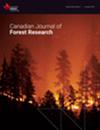Assessing the influence of climate on the growth of green ash trees from five Plant Hardiness Zones growing in a range-wide provenance test near the species’ northern range limit
IF 1.7
3区 农林科学
Q2 FORESTRY
引用次数: 0
Abstract
Green ash is threatened with extirpation from emerald ash borer (EAB) attack. Because green ash has an extensive range, its restoration could require both breeding for EAB resistance and possible adaptation to a variety of environmental gradients. We assessed the growth and climate sensitivity of green ash from five Plant Hardiness Zones (PHZs) growing in a range-wide provenance test in Vermont. Although there tended to be greater growth among trees from the warmest PHZ (7), differences were rarely statistically distinguishable. For trees from all PHZs, growth was positively correlated with precipitation in the current year and negatively correlated with precipitation the year before (a possible legacy effect). Growth was negatively associated with temperature the year of ring formation but positively associated with temperatures the year before. Growth was often positively correlated with winter snow but was negatively associated with spring or fall snow for the warmest PHZs. Climate correlations for PHZ 3 were unusual in that: 1) only positive correlations were detected, 2) no legacy effects were noted, and 3) despite being from the coldest region, no correlations with snow were found. Growth increased over time for the warmest PHZs during a period of simultaneous increases in temperature and precipitation.评估气候对来自五个植物耐寒区的白蜡树生长的影响,这些白蜡树生长在该物种北部分布界限附近的一个全分布区原产地测试中
白蜡树受到翠蛾钻心虫(EAB)的侵袭,濒临灭绝。由于白蜡树的分布范围很广,要恢复它的生长可能既需要培育白蜡树的抗 EAB 能力,又需要适应各种环境梯度。我们评估了生长在佛蒙特州全范围原产地测试中的五个植物耐寒区(PHZs)的白蜡的生长和气候敏感性。虽然来自最温暖 PHZ(7)的树木往往生长得更快,但在统计上很少有明显的差异。对于来自所有 PHZ 的树木来说,生长与当年的降水量呈正相关,而与前一年的降水量呈负相关(可能是遗留效应)。生长与形成环当年的气温呈负相关,但与前一年的气温呈正相关。生长通常与冬季降雪呈正相关,但与最温暖 PHZ 的春季或秋季降雪呈负相关。PHZ 3 的气候相关性与众不同:1)只发现了正相关;2)没有发现遗留效应;3)尽管来自最寒冷的地区,但没有发现与雪的相关性。在气温和降水量同时增加的时期,最温暖 PHZ 的生长量随时间推移而增加。
本文章由计算机程序翻译,如有差异,请以英文原文为准。
求助全文
约1分钟内获得全文
求助全文
来源期刊
CiteScore
4.20
自引率
9.10%
发文量
109
审稿时长
3 months
期刊介绍:
Published since 1971, the Canadian Journal of Forest Research is a monthly journal that features articles, reviews, notes and concept papers on a broad spectrum of forest sciences, including biometrics, conservation, disturbances, ecology, economics, entomology, genetics, hydrology, management, nutrient cycling, pathology, physiology, remote sensing, silviculture, social sciences, soils, stand dynamics, and wood science, all in relation to the understanding or management of ecosystem services. It also publishes special issues dedicated to a topic of current interest.

 求助内容:
求助内容: 应助结果提醒方式:
应助结果提醒方式:


